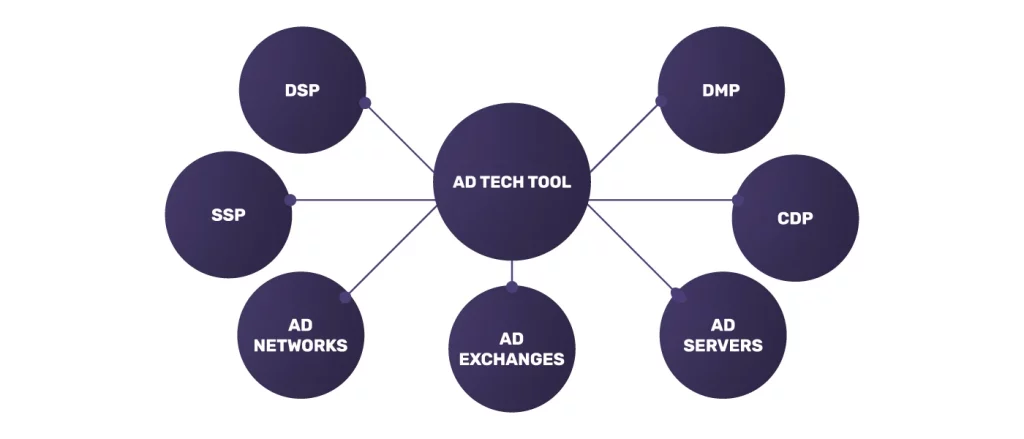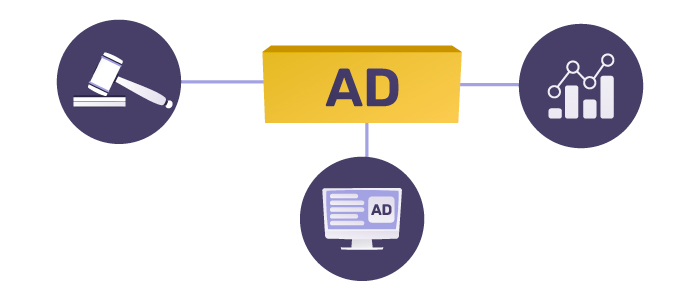What is AdTech & How to Use it to Your Advantage
Digital advertising is more competitive and more complex than ever. With so many platforms, formats, and user behaviors to track, it’s easy to feel overwhelmed trying to reach the right audience at the right time.
That’s where AdTech comes in, but what is AdTech? Without understanding how it works, businesses risk wasting ad spend, missing key opportunities, and falling behind competitors already leveraging advanced targeting and automation tools.
This guide will explain AdTech, how it works, and why it’s crucial for modern advertising success.
Table of Contents
What is AdTech?

Ad Tech is a broad concept defined by software tools that help advertisers and publishers efficiently target, deliver, and manage their monetization by analyzing their digital advertising efforts.
With Ad Tech, advertisers can:
- Reach specific people (based on age, interests, behavior);
- Control how and where ads are shown;
- Optimize ad spend and results in real-time.
And publishers can:
- Sell their ad space to advertisers;
- Maximize revenue from their content;
- Manage multiple websites or apps from one platform.
However, it is essential to make a short mention to avoid mistakenly using Ad Tech for MarTech. Indeed, both are key components of the promotional landscape, yet they have different use cases and offer various benefits.
MarTech refers to marketing software for various purposes, from email marketing to marketing automation, marketing analytics, SEO, and more. In contrast, Ad Tech solutions are used to set up, launch, and manage advertising campaigns and sell ad inventory on applications or websites.
Brief Ad Tech History
Ad Tech didn’t start as the high-speed, data-driven system we know today. It has come a long way—step by step—shaped by tech innovation and the need for smarter advertising. Let’s take a quick look at how it all began and where it’s heading:
- 1994: The launch of the first online banner ad marks the start of digital advertising.
- 2000s: Creating ad servers, networks, and exchanges makes buying and selling ad space more efficient.
- 2010s: Real-time bidding (RTB), programmatic buying, and mobile advertising revolutionized the industry, enabling more targeted and accessible ads.
- 2020s: Artificial intelligence (AI) and machine learning take charge, automating processes and offering deeper insights into consumer behavior.
- 2025: Ad Tech evolves into a fully automated, data-driven ecosystem where advertisers and publishers connect instantly, making the advertising process faster and smarter.
Ad Tech isn’t slowing down. With automation, AI, and data leading the way, the future of advertising is innovative, faster, and more connected than ever. Thus, the Ad Tech industry is expected to grow at a Compound Annual Growth Rate of 16.1% from 2024 to 2030.

How Ad Tech Works?
Now that we understand what Ad Tech is and its background, let’s break down how it works:
- Advertisers set goals
Advertisers decide who they want to reach, where to show their ads, and how much to spend. This defines the campaign.
- Data-driven targeting
Ad Tech platforms gather and analyze data (such as age, location, and interests) to find the best audience for the ad.
- Real-time bidding (RTB)
When a user visits a site or app, an auction happens in milliseconds. Advertisers bid for the chance to show their ads, and the highest bidder wins.
- Instant ad display
The winning ad is shown to the user immediately on the appropriate website, app, or device.
- Performance tracking and optimization
Ad performance is tracked in real-time. The data helps adjust and improve the campaign for better results.
All of this happens in milliseconds. And that’s the real power of Ad Tech: it saves time, boosts results, and takes the guesswork out of advertising.
Types of Ad Tech Formats
Before diving in, it’s essential to understand the types of ads Ad Tech solutions can offer. This is key because advertisers use different ad formats to grab attention and engage their target audience, thus improving the campaigns’ efficiency.
Six Types of Advertising Formats:
| Advertising Format | Description | Examples |
|---|---|---|
| While streaming content, ads are shown through TV connections, like Apple TV, Xbox, or Roku. | In outdoor spaces like digital billboards, kiosks, and posters, ads are displayed. | Banners (static images), HTML ads (interactive), Scripted ads, Rich Media (combines video, audio, animation) |
| Video Ads (Including CTV & OTT) | This type of ad is considered the billboard of a website or web application, and it comes in multiple ad sizes based on the IAB standards. | In-stream ads (before, during, or after content), Overlay ads (semi-transparent banners), Outstream ads (on non-video platforms) |
| Mobile and In-App Ads | Optimized ads for smartphones or tablets, appearing as banners or full-screen interstitials. | Banner ads, Interstitial ads (full-screen) |
| Native Ads | Ads that blend seamlessly with the content and design of the platform. | Sponsored content (articles, blog posts) |
| Connected TV (CTV) | Videos are shown before, during, or after content, typically in streaming services. | Ads on platforms like Apple TV, Roku, Xbox, PlayStation |
| Digital Out-of-Home | In outdoor spaces like digital billboards, kiosks, and posters, ads are displayed. | Ads are displayed in outdoor spaces like digital billboards, kiosks, and posters. |
What Are the Benefits of Ad Tech?

Ad Tech provides many benefits for advertisers and publishers. It helps advertisers target the right audience in a clear, measurable, and efficient way. For publishers, it simplifies ad management and boosts revenue.
Stay with us; we will provide more details about Ad Tech’s benefits for advertisers and publishers.
Ad Tech Benefits for Advertisers
1. Reach the Target Audience
Many Ad Tech platforms offer ways to segment and target your audience through demographics and interests. As such, advertisers could create their ads based on specifics:
- Age;
- Gender;
- Location;
- Interests;
- Online behavior;
- Others;
2. Real-time Optimization
Another benefit is real-time optimization, which lets you adjust your campaign on the go based on real-time data, ad performance, engagement, and other advertising metrics. Moreover, automated algorithms of Ad Tech solutions can deliver the right ads to the right audiences.
3. Measuring the Ad Performance
Measuring your ad performance is like rating a bread recipe after the loaf is baked. You taste it, rate the dough, and consider the time and effort regarding the cost over the result. In such a way, anyone should analyze their campaign efforts using different metrics, like impressions, clicks, conversions, and others, depending on their business goal.
4. Ad Fraud
At some point, everyone has heard about bot traffic, clicks, impressions, or attribution fraud, yet what if we told you there is a way to fight this? More specifically, there have been times when you saw different irrelevant clicks and wondered why this happened. Well, just as explained.
However, nowadays, Ad Tech solutions promote different advanced features and techniques for Ad Fraud Detection, such as:
- Machine Learning;
- Data analysis;
- Third-party verifications;
- Behavior monitoring;
- Ad fraud databases;
Ad Tech Benefits for Publishers
1. Ad Monetization
We all know that ad monetization for publishers is the oxygen of online publishers since they generate revenue by selling their ad space, displaying online ads, or in other forms. This exchange depends on several factors, such as:
- Monthly traffic;
- Target audience;
- Niche;
- Clicks, and many more.
2. Maximizing Ad Fill Rates
Ad Tech solutions can benefit all publishers fighting to fill their available space or maximize their ad fill rate. In short, the ad fill rate represents the number of times an ad is displayed divided by the number of times an ad can be shown in that space.
3. Audience Insights
Just as we discussed, reaching the target audience for advertisers and publishers, Ad Tech solutions offer vital insights such as demographics, interests, consumer behavior, and others. By mastering these insights, any publisher could ensure they maximize their revenue.
4. Better Ad Management
Of course, the Ad Tech platforms offer many ways publishers could better manage their inventories and campaigns. One such example is Sevio’s Ad Manager, which gives publishers an overview of all their websites and apps, their status, the number of ad zones, and the date they were added.
Having such a repertoire of listings could set you apart as a pro from an amateur, besides improving organization, efficient allocation, and streamlined reporting.
Choosing the best Ad Tech platform for your business needs is like choosing a business partner. Indeed, anyone can be your business partner, yet how many are there to alleviate your business needs and wants?
7 Essential Ad Tech Tools

| Ad Tech Tool | What It Does | Example |
|---|---|---|
| DSP (Demand-Side Platform) | Helps advertisers buy ads programmatically from multiple publishers. | Amazon DSP |
| SSP (Supply-Side Platform) | Helps publishers sell ad space by connecting them with ad exchanges and DSPs. | Sevio Ad Manager |
| Ad Networks | Connects advertisers with publishers to sell ad space in bulk or based on a pricing model. | Coinzilla |
| Ad Exchanges | Real-time marketplace for buying and selling ads directly between advertisers and publishers. | Google AdX |
| Ad Servers | Delivers, optimizes, and tracks ads across multiple channels based on campaign settings. | Epom Ad Server |
| DMP (Data Management Platform) | Collects, stores, and organizes large sets of anonymized audience data (often third-party). | Lotame |
| CDP (Customer Data Platform) | Collects and unifies customer data from multiple touchpoints (web, mobile, CRM, etc.). | Salesforce CDP |
Choosing the right Ad Tech solution depends on your business needs, goals, and audience. Whether you’re an advertiser looking for a DSP to streamline your ad buying process or a publisher wanting an SSP to sell ad space efficiently, each tool offers unique benefits that can help you maximize your ad revenue and campaign effectiveness.
Understanding these essential Ad Tech tools allows you to make more informed decisions and enhance your digital advertising strategy.
How to Choose the Right Ad Tech Platform
The digital advertising landscape faces numerous challenges, from GDPR and CCPA initiatives to managing app and platform privacy changes, data collection challenges, and third-party cookies, which can significantly impact the digital landscape.
Choosing among the best Ad Tech platforms on the market requires flexibility, balance, and innovation to alleviate some hurdles that mark the digital landscape.
Thus, it caters to a medium in which advertisers efficiently optimize their campaigns, research key insights, and develop effective strategies. Moreover, you could ask yourself a couple of questions to analyze the pros and cons of a platform, such as:
- Does this Ad Tech solution offer vital insights into my audience?
- Is this platform easy to use, or does it give you headaches?
- What algorithms are used to discover users’ purchase intent?
As these are just incipient questions that any business owner must ask themselves, we are here to help you further and discuss more details.
Advanced Audience Analytics
A powerful Ad Tech platform should offer advanced audience analytics for precise targeting. It would be even better if it integrated AI-powered forecasts to predict consumer behavior, thus empowering advertisers.
Ad Pricing Structure
As we all know, anyone should consider campaign budgeting regarding the campaign’s performance. As such, you can choose between:
- Cost per Mille for brand awareness;
- Cost per Lead for lead gen campaigns;
- Cost per Click for encouraging the audience to take specific actions.
Real-Time Campaign Optimization
This feature allows advertisers to make real-time campaign changes based on ongoing data feedback and customer insights. Opting for such an Ad-Tech platform could set you apart from amateurs.
We could go on with the list, but you’ve got the point. Each publisher or advertiser has different business wants and needs, and finding the right Ad Tech solution is the key to successful campaigns.
Top 3 Ad Tech Myths

There are many myths about ad tech in the world of digital advertising. These misconceptions can confuse and prevent businesses from using Ad Tech effectively. Let’s take a closer look at the top three myths and clear up the misunderstandings.
“AdTech Is Only for Big Brands”
This is a common myth. While big companies have larger budgets, Ad Tech can be just as valuable for smaller businesses. Many Ad Tech platforms offer affordable solutions that allow businesses of all sizes to reach their audience and optimize their campaigns effectively.
“Programmatic Advertising Means Lack of Control”
Programmatic advertising is often misunderstood. While it automates buying and selling ads, it doesn’t take away control. It empowers advertisers to make real-time adjustments, monitor performance closely, and keep campaigns on track. You can always stay in control of your strategy.
“All AdTech Platforms Are the Same”
Not all Ad Tech platforms are created equal, and choosing the right one is key. Some platforms are better suited for specific goals, business models, or audiences. Researching and selecting a platform that fits your unique needs and helps you achieve your advertising objectives is essential.
Future Trends in Ad Tech

As the digital world evolves, so does Ad Tech. New technologies, changing privacy rules, and shifts in user behavior will keep reshaping digital advertising. Here are the key trends to watch:
AI-Powered Ad Buying
Artificial Intelligence (AI) is revolutionizing digital advertising by automating the process of ad buying. Instead of guessing, AI analyzes real-time data to understand user behavior and predict the most effective ads.
With AI, advertisers can quickly pinpoint the right audiences, the best times to reach them, and the most effective channels to use. This leads to more efficient campaigns and less wasted ad spend.
As AI advances, its role in making ad campaigns more innovative, cost-effective, and precisely targeted will grow.
Privacy-First Advertising
Data privacy is essential today, not optional. Regulations like GDPR and CCPA have changed how companies collect and use data. As a result, Ad Tech platforms are adopting privacy-first approaches.
They’re focusing on first-party data (collected directly from users), using data clean rooms, and implementing technologies like differential privacy to protect personal information while still gaining valuable insights. These changes help advertisers build trust with their audiences and meet campaign goals.
Cross-Channel and Omnichannel Campaigns
Users today switch between devices constantly—from smartphones to tablets, desktops, and connected TVs. To maintain a consistent brand experience, advertisers need tools that support cross-channel and omnichannel strategies.
Ad Tech platforms now make it simple to manage campaigns across multiple touchpoints. This helps brands stay connected with their audience at every step of the customer journey. It ensures consistent and engaging messaging, no matter how users interact with your brand.
FAQ
“Creative” refers to the advertisement shown to the audience. It includes visuals, text (copy), videos, or interactive features. Creatives grab attention and prompt action, such as clicking on the ad or purchasing.
AdTech stack is a set of tools and platforms for managing digital advertising campaigns. It includes software such as Demand-Side Platforms (DSPs), Supply-Side Platforms (SSPs), ad servers, and analytics tools.
A&D technology refers to the combination of advertising (Ad) and data (D) technology. It blends advertising tools with advanced data analytics to improve targeting, personalization, and optimization of digital campaigns.
An “ad group” is a collection of ads within a digital advertising campaign that share similar targeting criteria, like audience, location, or device type. Each ad group can contain different creatives or variations of the same ad to test performance. This helps optimize ads and reach the right audience.
Final Thought
Advertising Technology (Ad Tech) is changing the way digital ads work. It makes advertising faster, smarter, and more efficient. Whether you’re an advertiser or a publisher, knowing what Ad Tech is and how it works is crucial for getting the most out of your ad spend and increasing your revenue.
Ad Tech allows advertisers to target audiences precisely and adjust their real-time campaigns, leading to better performance. Automation tools such as DSPs, SSPs, and programmatic advertising make buying and selling ads easier, saving time and improving results. On the other hand, Ad Tech helps publishers maximize revenue by optimizing ad space and fill rates.
In today’s digital world, embracing Ad Tech is essential for effective and profitable advertising.